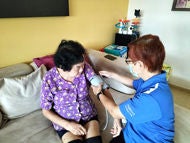What is - Vaginal Birth After Caesarean Section (VBAC)
VBAC, pronounced as “Vee Back”, stands for “Vaginal Birth After Caesarean Section”. This means giving birth vaginally (either normal delivery or assisted by using forceps or vacuum cup) after having had a previous caesarean section.
If I had one previous caesarean section birth, can I go through a subsequent vaginal birth?
If you have had one previous uncomplicated caesarean section and your current pregnancy has been straightforward, you may choose to attempt a VBAC. When considering your options on how you want to deliver your baby having had a previous caesarean section, your doctor will take into account your previous pregnancies and medical history and discuss with you at your antenatal visits.
Generally, some relevant factors to determine suitability for VBAC are as follows:
Previous caesarean section
• Type of incision
This refers to the manner in which the womb was incised during the delivery in the last pregnancy.
(a) “Classical caesarean section” refers to a vertical incision in the upper part of the womb. Women who have had a previous classical caesarean section are not advisable to attempt vaginal birth as there is a high risk of scar separation/tear (rupture).
(b) “Lower segment caesarean section” refers to a horizontal incision on the lower part of the womb. This method is associated with a lower risk of scar rupture and women with this type of incision may opt for VBAC after one previous caesarean section.
• Reason for the previous caesarean section
If the reason for the previous caesarean section is a recurring one such as cephalopelvic disproportion (CPD), where the pelvis is too small to allow the passage of the baby’s head, then VBAC may be unsuitable.
• Complications during the previous caesarean section
If the previous caesarean section was complicated by unexpected tears in the uterus, your obstetrician may advise for repeat caesarean section in the subsequent pregnancy.
• Current pregnancy
Certain conditions such as a low-lying placenta or abnormal presentation of the baby in this current pregnancy e.g. breech presentation will make you an unsuitable candidate for VBAC.
• Other medical/surgical problems
Certain medical conditions such as certain heart diseases or severe hypertension would prevent a woman from enduring the physical stress of a vaginal delivery. Previous surgery on the uterus e.g. to remove fibroids may increase the risk of rupture of the womb during labour. In such cases, VBAC may not be suitable.
What if I had more than one caesarean section?
With increasing number of previous caesarean sections, the risk of complications increase. If you have had more than one caesarean section and are considering a vaginal birth, you should have a detailed discussion with your doctor about the risks, benefits and success rate in your individual situation. It is not routine practice in our institution to offer a VBAC for this situation due to a higher risk of scar rupture.
What is the likelihood of a successful VBAC?
About 60 to 70% of women with a straightforward pregnancy will achieve a successful VBAC after one caesarean section. Women who have had previous vaginal birth before or after your caesarean section, especially if you have had a previous successful VBAC have a higher success rate of 80 to 90%.
What are the advantages of a successful VBAC as compared with elective caesarean delivery?
A successful VBAC has fewer complications as compared with elective caesarean delivery. You will have a greater chance of a vaginal birth in future pregnancies, quicker recovery with shorter hospital stay, lesser bleeding and post-delivery pain, lesser chance of needing blood transfusion and getting an infection. You can also avoid risks of caesarean delivery and your baby will have lower risk of getting initial breathing problems. The cost of a successful VBAC is lower than a caesarean section.
What are the disadvantages and complications associated with VBAC?
The primary concern associated with VBAC is the risk of scar separation/tear (rupture). The incidence of scar rupture is less than 1% after one previous lower segment caesarean section. If there are warning signs of scar rupture, your baby will be delivered by emergency caesarean section.
Serious consequences due to scar rupture are rare, and include massive blood loss, a need for surgical removal of the womb (hysterectomy) and ICU stay in the mother, and also fetal death or cerebral palsy (neurological impairment) for the child. These consequences can sometimes be life-threatening for both you and your baby.
If you need an emergency caesarean section during labour, there are higher risks of complications for the mother as compared to an elective caesarean section or a successful VBAC. The most common reasons for an emergency caesarean section are if your labour is not progressing or there is a concern about the wellbeing of your baby. The costs of a failed VBAC would also be higher.
You may also need an assisted vaginal birth using a forceps or a vacuum cup, and may experience a tear involving the muscle that controls the anus or rectum (third or fourth degree tear) during a vaginal birth.
What happens if I am suitable and planning for a VBAC?
You will be advised to come to the labour ward early once you start having regular contractions or when your waters break, so that your baby’s heartbeat can be monitored continuously during labour as any change in the heartbeat pattern can be a sign of scar rupture. An emergency caesarean section will be performed in this case.
Can I opt for epidural pain relief if I have decided for VBAC?
Epidural is commonly used in labour to provide effective pain relief. In addition, if trial of labour fails, epidural can be continued as a form of anaesthesia for emergency caesarean section to be carried out.
What happens if I do not go into labour when I plan for a VBAC?
If you do not go into labour by 40 to 41 weeks, your doctor will discuss your birth options with you again. Induction of labour for women who have had a caesarean section increases the risk of scar rupture. You may then opt for a caesarean delivery.
What if I opted for an elective caesarean delivery but I go into labour before my scheduled caesarean delivery date?
An emergency caesarean delivery can be arranged and performed once labour is confirmed. If your labour is very advanced, it may be safer for you and your baby to have a vaginal birth. Your doctor or the doctor on duty in labour ward will discuss this further with you.
Making a choice for birth after one caesarean section
A decision for or against VBAC should be a joint discussion between you and your obstetrician after having taken into consideration the pros and cons of VBAC in your situation. Once this decision is made, your obstetrician will fully support you in your decision.
Vaginal Birth After Caesarean Section (VBAC) - Other Information
Contributed by
The information provided is not intended as medical advice. Terms of use. Information provided by SingHealth.
Our Medical Specialists
Get to know our doctors at SingHealth Hospitals in Singapore.
Get to know our doctors at SingHealth Hospitals in Singapore. here.
Our Medical Specialists
1
2
3
4
5
Health Articles




















